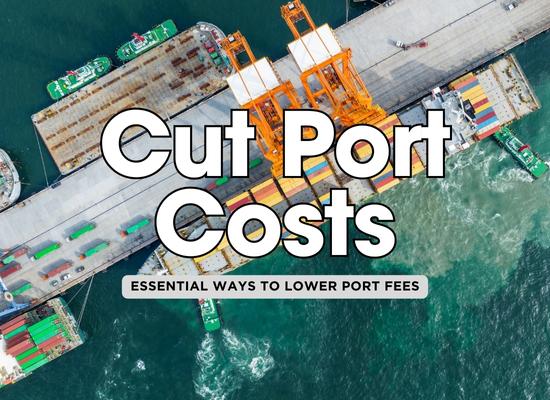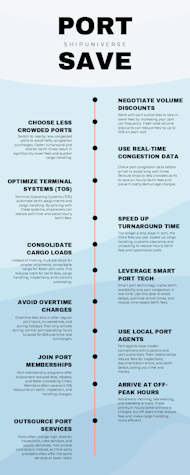12 Proven Ways to Cut Port Fees Fast

Port fees and charges are a substantial expense for ship and fleet owners, often cutting into profit margins. But these costs aren't fixed. By using strategic methods, shipowners can unlock significant savings. From smarter port selection to optimizing terminal operations, every decision adds up. Today we go over 12 practical strategies to reduce port fees and streamline costs.
Infographic: Smart Strategies for Cutting Costs 💰⚓
This infographic highlights 12 actionable ways to reduce port fees. From negotiating volume discounts to leveraging smart technology, discover practical tips to save money and optimize operations at every port call!

1️⃣ Negotiate Volume Discounts with Ports
Securing volume discounts is one of the most effective ways for shipowners to lower port-related expenses. Ports are open to offering price breaks to fleet owners who provide steady traffic or long-term commitments.
- 📋 The Strategy: Ports have standard tariff sheets for fees, but these aren’t set in stone. Fleet owners with multiple port calls can negotiate reduced rates, especially if they have several ships making regular visits.
- 💡 Insider Advice: Bundle all ship movements under one agreement. If you have multiple vessels calling at the same port, negotiate a bulk rate for all of them combined.
- 💸 Savings Snapshot: Discounts typically range from 5% to 20%, which can add up fast. For example, if port fees are $15,000 per visit and you secure a 10% discount, that’s a $1,500 savings per visit.
- 📊 Example in Action: A fleet of six ships calling on the same port monthly, with an average port fee of $12,000 per call, could save up to $86,400 annually with a 12% volume discount.
- 🔑 Key Tip: Build long-term relationships with port managers and decision-makers. Loyalty and familiarity often unlock better terms.
2️⃣ Use Alternative, Less Congested Ports
Rerouting to alternative, less congested ports can deliver big savings. While major ports offer convenience, they also come with congestion charges, demurrage fees, and longer berth times. Lesser-known ports may have shorter wait times and cheaper fees.
- 🌍 The Approach: Don’t default to large, high-traffic ports. Regional ports often have smaller fees, shorter waits, and less bureaucracy. This allows for quicker cargo discharge and reduced berth fees.
- 💡 Insider Advice: Use tools like Port Congestion Tracking Software to identify overburdened ports and find better alternatives. Knowing which ports are experiencing delays gives you a head start.
- 🕒 Time Saved: Shorter waiting times reduce berth fees, which are often charged hourly. Fewer delays mean less downtime for crew and faster cargo turnaround.
- 💸 Cost Breakdown: Choosing an alternative port can reduce fees by 10-30%, depending on port location and size. For instance, if a ship pays $20,000 at a large port but switches to a smaller port with $15,000 in fees, they save $5,000 per visit.
- 🔑 Key Tip: Work with port agents or freight forwarders who can provide inside knowledge on less-congested ports nearby. These agents often have the latest data on which ports are the best option.
3️⃣ Track Port Congestion in Real Time
Live port congestion data is a game-changer for shipowners. Avoiding congested ports helps minimize berth delays, reduce demurrage fees, and ensure faster port calls.
- 📡 The Method: Use real-time port congestion platforms (like MarineTraffic) to monitor port capacity and ship traffic. These platforms track which ports are backed up and suggest better alternatives.
- 💡 Insider Advice: Adjust your voyage route mid-journey if congestion spikes. Many fleet management platforms can automate re-routing suggestions to avoid high-traffic areas.
- 💸 Cost Reduction: Avoiding congestion can reduce demurrage and berth fees by thousands per day. For example, ships stuck at port for an extra 24 hours may pay an extra $2,500 to $10,000, depending on the port.
- 📊 Example in Action: Imagine a ship originally scheduled to dock at a port with a 3-day delay. By re-routing to a nearby port with only a 6-hour delay, you save two full days of berth fees, which could total $20,000+ in savings.
- 🔑 Key Tip: Incorporate congestion data into voyage planning software. This allows for on-the-fly course adjustments that avoid costly delays and excessive port fees.
4️⃣ Maximize Use of Terminal Operating Systems (TOS)
Modern Terminal Operating Systems (TOS) streamline port operations, reducing delays and optimizing ship handling. By aligning with TOS platforms, shipowners can significantly cut fees tied to berth time and demurrage.
- ⚙️ The Strategy: Terminal Operating Systems (TOS) manage the movement of ships, cargo, and port resources. By integrating with these systems, shipowners can pre-schedule dock times, reduce berth stays, and improve load/unload efficiency.
- 💡 Insider Insight: Use a pre-arrival cargo manifest to notify ports of the cargo details in advance. This allows the port to allocate cranes and labor efficiently, leading to faster turnaround times.
- ⏳ Time Reduction: TOS helps reduce berth time, which cuts per-hour berth fees. Each hour saved at the dock could mean $1,000 to $5,000 in cost reduction, depending on the port.
- 💸 Example in Action: A ship with a 3-day berth allocation that optimizes through TOS, reducing it to 2 days, can save $12,000 to $25,000 in port fees.
- 🔑 Key Tip: Integrate your ship's systems with the TOS software of the ports you frequently use. Many ports offer API connections that sync ship schedules with port software.
5️⃣ Join Port Alliance or Membership Programs
Becoming part of a port alliance or membership program can unlock exclusive discounts on fees, streamline payments, and reduce administrative overhead.
- 🤝 The Strategy: Some ports offer loyalty-based membership programs that reward shipowners with lower fees for repeated port calls. These alliances often provide rebates, lower fees, and exclusive perks.
- 💡 Insider Insight: Look for ports with membership options for frequent users. Some ports, especially in Europe and Asia, have dedicated “Port User Groups” that offer fee reductions.
- 💸 Cost Savings: Shipowners can receive reductions of 5% to 15% on dockage, cargo handling, and berth fees through alliance memberships.
- 📊 Example in Action: A fleet owner who makes 20 port calls a year at a fee of $10,000 per call could save $20,000 to $30,000 annually by joining a port membership program.
- 🔑 Key Tip: Check if your ports of call offer alliances for frequent users. If they don’t, ask about "Port User Groups" that provide fee rebates for consistent usage.
6️⃣ Minimize Port Stay Time with Faster Turnaround
The longer a ship stays at port, the higher the fees. Reducing turnaround times is one of the most effective ways to lower port-related costs.
- 🚀 The Approach: Optimize loading, unloading, and customs clearance to shorten port stays. Berth fees are often charged hourly or daily, so faster cargo handling means lower costs.
- 💡 Insider Insight: Use advance cargo declarations to reduce customs clearance delays. If customs processing takes place before arrival, the ship can unload faster and depart sooner.
- ⏳ Time Reduction: Cutting just 6 hours off a port stay could save $2,000 to $10,000 depending on the port's hourly berth rate.
- 💸 Example in Action: A shipowner with a vessel paying $1,500 per hour for berth time saves $9,000 by reducing a 72-hour port stay to 66 hours. Multiply this by multiple port calls, and the savings add up fast.
- 🔑 Key Tip: Synchronize crew workflows, customs clearance, and cargo handling to reduce port time. Use voyage management software to ensure optimal scheduling.
7️⃣ Avoid Overtime and After-Hours Charges
Ports operate on set schedules, but any work done outside standard hours often comes with hefty overtime fees. Avoiding after-hours services is a simple but highly effective way to save on port fees.
- 🕒 The Approach: Plan your ship's arrival to fall within regular port operating hours. Ports charge overtime for customs inspections, cargo handling, and labor performed during nights, weekends, or holidays.
- 💡 Insider Insight: Use voyage planning software to ensure arrivals occur within standard port hours. Most ports publish their "standard hours" online, so plan accordingly.
- 💸 Cost Avoidance: Overtime fees range from 10% to 50% higher than standard fees. Avoiding a single 8-hour overtime shift could save $5,000 to $15,000 depending on the port.
- 📊 Example in Action: If a ship arrives at 7 p.m. instead of 3 p.m., it may be hit with overnight fees. Planning arrival for the next business morning avoids the premium rates, cutting down fees by thousands.
- 🔑 Key Tip: Never plan arrivals on Fridays or public holidays, as this can force your crew into after-hours rates over the weekend. Use real-time ETA adjustments to avoid costly scheduling mishaps.
8️⃣ Leverage Local Port Agent Relationships
Port agents are the bridge between shipowners and port authorities. A strong relationship with a reputable port agent can lead to better pricing, faster processing, and fewer mistakes that result in extra fees.
- 📡 The Approach: Port agents act as your "insider" at the port, managing customs, cargo operations, and berth bookings. Building a relationship with the right agent can result in smoother operations and fee reductions.
- 💡 Insider Insight: Use the same agent for multiple ports to build loyalty and trust. Agents often have access to reduced tariff rates and know how to avoid extra fees like demurrage, detention, and inspection charges.
- 💸 Savings Potential: Port agents may negotiate better berth fees and reduce “unforeseen costs” like inspection fees and cargo handling surcharges. These savings can amount to $2,000 to $10,000 per port call.
- 📊 Example in Action: A ship using an agent to negotiate customs fees may avoid charges for cargo re-inspection, saving $3,000 to $5,000. Agents also expedite the clearance process, reducing overall port stay time.
- 🔑 Key Tip: Choose agents with experience in the specific port region. They have stronger relationships with customs and port authorities, which can be invaluable in avoiding surprise fees.
9️⃣ Outsource Non-Core Port Services
Certain port services—like crew support, ship inspections, and documentation—can be outsourced to third-party providers. This reduces reliance on port labor, which is often more expensive.
- 🛠️ The Strategy: Use third-party service providers to handle inspections, provisioning, and documentation. Ports typically charge extra for these services, but private providers often have more competitive rates.
- 💡 Insider Insight: Hire third-party ship inspectors or surveyors instead of using port-authorized services. This avoids “port-exclusive” rates, which are higher than market rates.
- 💸 Savings Breakdown: The savings depend on the service. A ship inspection handled by port authorities may cost $3,000 to $6,000, while a private provider could complete it for half the price.
- 📊 Example in Action: A fleet owner hires a private contractor for a ballast water inspection at $1,500, instead of using the port's inspector at $4,000, saving $2,500.
- 🔑 Key Tip: Plan third-party services before arrival. Port schedules are rigid, so pre-booking inspectors and provision suppliers ensures they’re ready the moment you dock, reducing berth time.
🔟 Plan for Off-Peak Berthing Times
Arriving at ports during off-peak hours can drastically reduce fees. Ports often impose extra charges for peak-time arrivals and during periods of high demand, such as early mornings, late evenings, and weekends. Adjusting schedules to avoid these peak times can lead to significant cost reductions.
- 📅 The Approach: Time ship arrivals for non-peak hours. This often means scheduling arrivals during mid-morning, mid-afternoon, or early in the week instead of Fridays or Mondays.
- 💡 Insider Insight: Use automated voyage management software to calculate optimal arrival times based on real-time port traffic data. Avoiding port arrivals during crew shift changes or busy hours can eliminate unnecessary berth fees.
- 💸 Cost Avoidance: Port peak fees can be 10% to 25% higher than off-peak rates. Avoiding peak hours could save shipowners thousands of dollars per port call.
- 📊 Example in Action: A ship arriving at 6:00 a.m. may incur a $2,000 early arrival surcharge, but a shift to 9:30 a.m. (after peak) could avoid that fee entirely. Multiply this by multiple port calls, and it becomes a major saving.
- 🔑 Key Tip: Check port schedules for peak time definitions. Some ports classify peak hours as early mornings or late evenings, while others designate peak days (like Fridays) as premium periods. Knowing this in advance can save a lot.
1️⃣1️⃣ Consolidate Cargo for Fewer Port Calls
The fewer ports a ship visits, the lower the cumulative port fees. By consolidating cargo and optimizing routes, shipowners can reduce the number of port calls, leading to significant fee savings.
- 🚢 The Strategy: Combine multiple cargo loads from different customers into one larger shipment, reducing the need to stop at multiple ports. This strategy works well for fleet owners managing multiple vessels.
- 💡 Insider Insight: Use container consolidation hubs. Shipowners can consolidate containers from multiple suppliers into a single port call, cutting down on repetitive stops and cargo handling fees.
- 💸 Savings Snapshot: Each avoided port call can save $10,000 to $50,000 in cumulative port fees, including berth, inspection, and handling charges.
- 📊 Example in Action: A fleet owner previously calling at 5 ports for separate cargo collections now consolidates cargo at 2 ports. This eliminates 3 port calls, saving $90,000 annually on fees.
- 🔑 Key Tip: Use multi-cargo contracts with suppliers and shippers. This allows shipowners to negotiate consolidation terms with multiple suppliers to route all shipments through fewer ports.
1️⃣2️⃣ Use Smart Port Technology to Avoid Delays
Smart port technology offers real-time data on port conditions, berth availability, and processing times, allowing shipowners to avoid delays, speed up handling, and cut down on fees.
- 🌐 The Method: Smart ports use IoT (Internet of Things), AI, and predictive analytics to improve ship traffic flow. Ships that integrate with these systems receive real-time data on berth availability, dock conditions, and potential delays.
- 💡 Insider Insight: Ports with “Smart Port” designation often offer exclusive slots for digitally connected vessels. Smart ports like Rotterdam and Singapore offer access to berth scheduling software that lets shipowners avoid delay-related fees.
- ⏳ Time Reduction: Smart ports reduce average berth times by 10% to 20%, resulting in shorter port stays and lower hourly berth fees.
- 💸 Cost Savings: By using smart port data to avoid delays, a ship that spends 6 fewer hours at berth (at $2,000 per hour) could save $12,000 in a single visit.
- 📊 Example in Action: A ship reroutes to a port where berth availability is known via a smart system, avoiding a 24-hour delay and saving $24,000 in berth fees.
- 🔑 Key Tip: Integrate your ship’s systems with the port's smart platform to access live data on port congestion, available berths, and handling times. This gives fleet owners an edge in route planning and port choice.
Port fees are an unavoidable part of maritime shipping, but they don’t have to drain profits. By leveraging smart technology, better scheduling, and stronger industry relationships, shipowners can unlock substantial savings. Each of the 12 strategies outlined here offers a proven way to reduce costs — from negotiating volume discounts to using smart port data to avoid delays.
The key takeaway? Small changes lead to big savings. Whether it’s arriving during off-peak hours, consolidating cargo, or outsourcing non-core port services, every adjustment adds up. For fleet owners managing multiple ships, these savings multiply exponentially.
The maritime industry is becoming more data-driven, and shipowners who stay ahead of these trends will be better positioned to cut costs and boost profits. By adopting these strategies, fleet owners can take control of port fees, turning them from an unpredictable cost into a manageable one.
Table Summary
| ShipUniverse: Top 12 Ways to Save on Port Fees and Charges | ||
|---|---|---|
| Strategy | What It Means | How It Saves You Money |
| Negotiate Volume Discounts with Ports | Secure lower port fees by committing to higher traffic volumes or multiple ship visits to the same port. | Discounts range from 5% to 20%, potentially saving thousands on each port call, especially for large fleets. |
| Use Alternative, Less Congested Ports | Avoid high-traffic, expensive ports by selecting less congested ports nearby that offer lower rates and shorter wait times. | Switching ports can cut port fees by 10-30% while reducing berth fees from shorter wait times. |
| Plan for Off-Peak Berthing Times | Schedule arrivals for off-peak hours to avoid "peak period" port charges, especially at night, early morning, or weekends. | Avoid after-hours fees and premium charges, saving up to 25% on berth fees. |
| Consolidate Cargo for Fewer Port Calls | Reduce the number of port stops by consolidating cargo into fewer, larger shipments instead of multiple smaller stops. | Fewer port stops reduce fees for berth, inspections, cargo handling, and customs charges, saving thousands annually. |
| Track Port Congestion in Real Time | Use real-time congestion data to identify and avoid ports with long delays or full berths, rerouting ships as needed. | Avoid delays and berth fees that can cost $1,000+ per hour. Rerouting saves thousands on each visit. |
| Maximize Use of Terminal Operating Systems (TOS) | Use port systems that automate ship scheduling, berth assignments, and cargo handling to reduce time at port. | Shorter port stays mean fewer hourly berth fees, saving up to $1,000 per hour on port charges. |
| Join Port Alliance or Membership Programs | Join port membership programs that offer fee discounts, rebates, and faster processing for members. | Members get fee reductions and rebates of 5-15% per call, with potential annual savings of tens of thousands. |
| Minimize Port Stay Time with Faster Turnaround | Speed up loading/unloading times by pre-arranging customs, cargo, and crew schedules to reduce berth time. | Faster turnarounds reduce berth fees, which are often charged hourly. Every hour saved reduces fees significantly. |
| Avoid Overtime and After-Hours Charges | Arrive during standard port operating hours to avoid overtime rates, weekend fees, and after-hours charges. | Avoid 10-50% surcharges on inspections, cargo handling, and port services by scheduling normal-hour arrivals. |
| Leverage Local Port Agent Relationships | Work with local port agents who have relationships with port authorities and can negotiate better rates and speed up clearance. | Agents help avoid unnecessary fees, speed up inspections, and reduce berth time fees. Savings vary, but it’s substantial over time. |
| Outsource Non-Core Port Services | Instead of using port-authorized inspectors and service providers, hire third-party companies for inspections, provisioning, and crew support. | Private inspectors and service providers often charge less than port-based services, reducing fees for inspections and handling. |
| Use Smart Port Technology to Avoid Delays | Leverage smart port systems and live port data to avoid delays, track berth availability, and optimize port arrivals. | By reducing delays and arrival times, shipowners save on berth fees and avoid penalty fees for late arrivals. |

Do you have a Maritime Product or Service that may be of interest to Shipowners? Tell us about it here!
Do you have feedback or insights? Please reach out to editor @ shipuniverse.com




